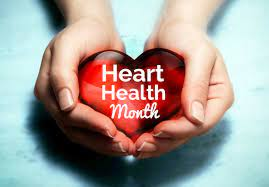Teach MAM
Teach MAM: An Exciting Partnership to Strengthen Arts Education Across Louisiana

TEACH MAM
February is Heart Health Month
Written by Keyré Bradford
Teach MAM Movement Ambassador
“American Heart Month provides an important opportunity to
emphasize the sharing of best practices, aligning measurements, advancing implementation strategies, and
providing leadership to focus on the burden of cardiovascular disease (www.acc.org 2017).”

During February we recognize “American Heart Health Month” and dedicate this time to motivating people to adopt a healthy lifestyle and utilize the best measures to prevent heart disease.
Most people think that heart disease is a problem for others and that they will never have to deal with its harmful effects. However, according to the Centers for Disease Control and Prevention, heart disease is the number one killer in the U.S. (Centers for Disease Control and Prevention 2022). Heart disease affects all ages, genders, and ethnicities. Heart disease risk factors include high cholesterol, high blood pressure, smoking, diabetes, and excessive alcohol use (www.nationaltoday.com, 2023).
Heart disease occurs when the arteries leading to the heart become clogged. Although heart disease has been around for thousands of years, many aspects of modern life exacerbate risk factors and make people more prone to heart disease and heart failure. Today, one in four deaths in the U.S. is attributable to heart disease. While heart disease can affect everyone, taking stock of your prior health risks, activities, and diet can help reduce your risk (www.nationaltoday.com, 2023).
In an effort to prevent heart disease, you should follow the 7 Preventive measures below:
- Understand your risk. Beginning your journey to combat heart disease, you should understand the risk associated with the disease and how your body may be affected. Your risk depends on many factors, some of which are changeable and others that are not. Risk factors are conditions or habits that make a person more likely to develop a disease. These risk factors may be different for each person. Preventing heart disease starts with knowing your risk factors and what you can do to reduce them. (https://www.nhlbi.nih.gov/2021).
- Have your blood pressure and cholesterol checkedwith your healthcare provider.
- Aim for a healthy weightand discuss your options with your health care provider. Determining a healthy BMI is crucial to heart health success. Body mass index (BMI) determines whether you are at a healthy weight. Adults are underweight if their BMI is below 18.5 and are at a healthy weight if their BMI is 18.5 to 24.9. Adults are overweight if their BMI is 25 to 29.9 and have obesity if their BMI is 30 or above (https://www.nhlbi.nih.gov/2021).
- Choose heart healthy foods. Choose a diet rich in vegetables, protein, and fruits while limiting your intake of saturated and trans fats and added sugars.
- Manage your level of stress.Coping with and managing your daily stress can lead to a healthy mental state.
- Get a minimum of 60 minutes of daily exercise.
- Get enough sleep. Sleep plays a vital role in good health and well-being throughout your life. During sleep, your body supports healthy brain function and maintains physical health. Not getting enough or good-quality sleep over time can raise your risk for chronic health problems. In addition, the amount of sleep you need each day will change throughout your life (https://www.nhlbi.nih.gov/2021).
One of the largest agencies on heart health and preventive measures is the American Heart Association. For nearly a century, the American Heart Association(www.heart.org) has worked to encourage people to live healthier and longer, free of heart disease and stroke.

The American Heart Association and other organizations reinforce the importance of heart health and the need for more research and efforts to ensure that millions of people live longer and healthier lives (www.heart.org, 2022).
Here are just a few examples of how you can reclaim your health:
- Doing at least 150 minutes of moderate-intensity physical activity a week (or just getting started and working your way there!)
- Eating healthy (the AHA’s Heart-Checkmark can guide you in the grocery store)
- Not smoking or vaping
- Maintaining a healthy weight
- Controlling blood sugar, cholesterol, and blood pressure
- Getting regular checkups
- Learning Hands-Only CPR
- Following COVID-19 safety protocols
- Finding ways to relax and ease your mind, such as meditation
If you ever find yourself feeling pain or discomfort in your chest, do not take those feelings lightly. Most heart attacks are sudden and can be intense or mild in nature.
- Chest discomfort. Most heart attacks involve discomfort in the center of the chest that lasts more than a few minutes, or the pain goes away and comes back. It can feel like uncomfortable pressure, squeezing, fullness or pain.
- Discomfort in other areas of the upper body. Symptoms can include pain or discomfort in one or both arms, the back, neck, jaw or stomach.
- If you ever feel pain or discomfort in your chest, do not take those feelings lightly. Most heart attacks are sudden and can be intense or mild in nature.
- Chest discomfort. Most heart attacks involve discomfort in the center of the chest that lasts more than a few minutes or goes away and returns. It can feel like uncomfortable pressure, squeezing, fullness, or pain.
- Discomfort in other areas of the upper body. Symptoms can include pain or discomfort in one or both arms, the back, neck, jaw, or stomach.
- Shortness of breath that may occur with or without chest discomfort.
- Other signs may include breaking out in a cold sweat, nausea, or lightheadedness.
As with men, women’s most common heart attack symptom is chest pain or discomfort. However, women may experience other symptoms typically less associated with heart attack, such as shortness of breath, nausea/vomiting, and back or jaw pain (www.heart.org, 2022).
What should I do if I suspect a heart attack?
Even if you are not sure it is a heart attack, immediately call 9-1-1 or your local emergency medical services (EMS), such as the fire department or ambulance. EMS staff can begin treatment when they arrive — up to an hour sooner than if someone gets to the hospital by car. People with chest pain who arrive at the hospital by ambulance also usually receive faster treatment (www.heart.org, 2022)
In most cases, heart disease is preventable when people adopt a healthy lifestyle, which includes not smoking, maintaining a healthy weight, controlling blood sugar and cholesterol, treating high blood pressure, getting at least 150 minutes of moderate-intensity physical activity a week, and getting regular checkups (www.heart.org, 2022).
How Can I Learn More?
* Call 1-800-AHA-USA1 (1-800-242-8721), or visit www.heart.org
to learn more about heart disease and stroke
* Sign up for a monthly Heart Insight e-news for heart patients and their families at www.HeartInsight.org.
* Connect with others sharing similar journeys with heart disease and stroke by joining the Support Network at www.heart.org/SupportNetwork.
Nearly half of all U.S. adults have some form of cardiovascular disease
(American Heart Association, 2019)
With such alarming statistics, we Americans need to heed the advice our healthcare professionals provide. In addition, we need to be diligent in improving our health. By making a few simple daily life choices, we can lower the statistics on cardiovascular disease and improve our overall health and well-being.
Get up! Get Moving! Make good choices!
Become Heart Healthy!
References:
“What Are The Warning Signs Of A Heart Attack?” American Heart Association, January 2023. https://www.heart.org/-/media/Files/Health-Topics/Answers-by-Heart/What-Are-the-Warning-Signs-of-Heart-Attack.pdf
“Heart Attack, Stroke and Cardiac Arrest Symptoms, Warning Signs of Heart Attack, Stroke and Cardiac Arrest.” American Heart Association, January 2023. https://www.heart.org/en/about-us/heart-attack-and-stroke-symptoms
“What Is Coronary Heart Disease?” National Heart, Lung, And Blood Institute, March 2022. https://www.nhlbi.nih.gov/health/coronary-heart-disease

